CAMT 2011 – Grapevine, TX
Christopher Boyd & Jason Gigenbach
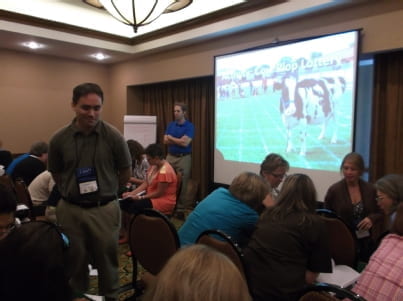
Have Fun with Probability: The Cow Plop Lottery
The cow plop lottery is a fun introduction to probability. Each student determines his or her chance of winning by simply comparing the area of their plot of land to the whole field. In this scenario, plots are divided in such a way that the dimensions are irregular fractions which must be measured with non-standard rulers! In this activity, The University of Texas at Arlington GK-12 Mathematician in Residence and mentor teacher support the students in a learning activity where simple probability and equivalent forms of rational numbers found in 8th grade mathematics are linked to the real world and research mathematics. This was developed for the NSF GK-12 MAVS Project that focuses on bringing research mathematics into the K-12 classroom at a level appropriate for K-12 students.
Ashlee Defilippis & Antonio Lopez
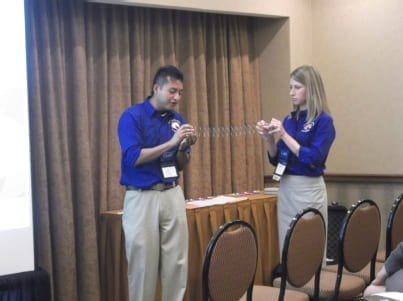
Understanding Algebraic Solutions Through Wave Applications
With all the advances in communications technology, such as cell phones and laptops, what underlying mathematical principles make it possible to separate electromagnetic waves interfering with one another? The study of wave behavior helps to understand the answer to this relevant question. Many algebra students wonder and ask, “Why do we need to learn Algebra?” Using classroom-tested activities, we will connect basic algebraic properties to the solutions of wave equations, showing students a useful application of algebra to research-level applied mathematics. This was developed for the NSF GK-12 MAVS Project that focuses on bringing research mathematics into the K-12 classroom at a level appropriate for K-12 students.
Alicia Geppert & Catherine Rogers
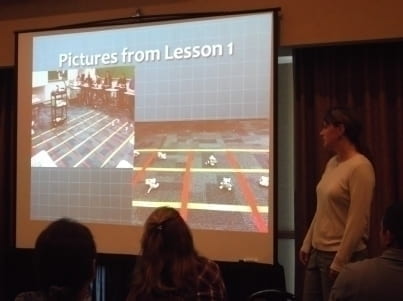
Even Freshmen Can Understand Mathematics Research!!
How many times have you been asked “when will I ever use Algebra??” Come see how Algebra I is used in Biology to model real life experiments. Through the NSF GK-12 MAVS Project, we have successfully demonstrated that even regular 9th graders can understand and be interested in mathematics research. Come see the activities and lessons we used to get freshmen interested in higher level math. This was developed for the NSF GK-12 MAVS Project that focuses on bringing research mathematics into the K-12 classroom at a level appropriate for K-12 students.
Kimberly Helixon & Angela Brown
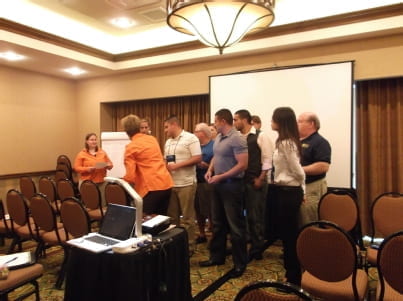
Bringing Finite Geometry to a Double Block Algebra/Geometry Class
Most high school algebra and geometry students have never seen geometries other than Euclidean geometry. By using knowledge from Algebra 1 coursework, we are able to introduce finite projective geometries. In this presentation, we will introduce six lessons covered during the school year in which projective geometries were explored and lead the participants through one of the student activities used in the classroom. This was developed for the NSF GK-12 MAVS Project that focuses on bringing research mathematics into the K-12 classroom at a level appropriate for K-12 students.
Gina Kaucher & Jason Bacon
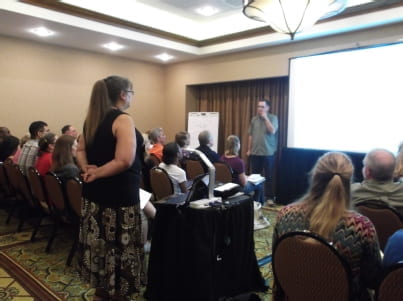
Duck, Duck, Algebra II?
We play a game of “Duck, Duck, Groups” to illustrate the important idea of invariance in higher level mathematics. We see that when working with transformations of functions in Algebra II or Precalculus there are certain features of a function which do not change under certain transformations. For example, when we create a new function from a parent function by multiplying it by a parameter a, the zeros of the parent function and the newly formed function are the same. We say this feature was invariant under the described transformation. We explore how to connect research level abstract mathematics to appropriate concepts in high school courses. This was developed for the NSF GK-12 MAVS Project that focuses on bringing research mathematics into the K-12 classroom at a level appropriate for K-12 students.
Kelli Randell & Padmini Veerapen
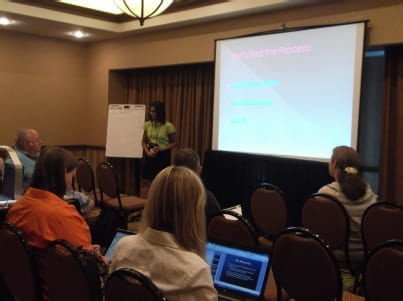
What’s all the fuss about the Commutative Property?
Noncommutative Algebra is a growing area in mathematics research. In this session, come join us as we delve into activities that explore how noncommuting variables give rise to mathematics to which junior high students can relate. Using clock arithmetic, we will first emphasize the commutative property of real numbers. We will then use real-life applications, for example, friends lining up to buy tickets at Six Flags to show the prevalence of noncommutativity around us. We will also have other activities to highlight different aspects of noncommutative algebra. The aim is to approach a difficult concept at an understandable and interesting level while reinforcing concepts that 7th-grade Pre-Algebra and 7th-grade mathematics students typically learn in class. This was developed for the NSF GK-12 MAVS Project that focuses on bringing research mathematics into the K-12 classroom at a level appropriate for K-12 students.
Thang Tran & Justin Blackwell
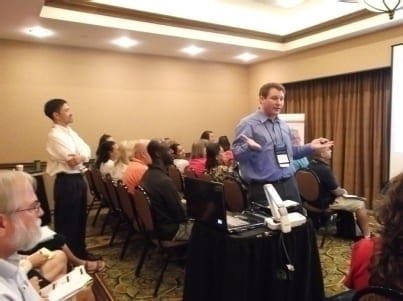
Matrices, What Good Are They?
When teaching matrices to high school students all teachers must answer the age old question, ‘Why are we learning this?’ Matrices are an essential element in mathematics research and are involved in much more than just solving a system of two or three equations. In this presentation we will illustrate the importance of and applications of matrices, and matrix operations, beyond the standard problems in high school curriculum. As a part of the NSF-funded GK-12 MAVS program, a graduate fellow and a mentor teacher worked together in the classroom to present graduate-level research at an appropriate level for high school students. In the fellow’s research, matrix techniques are used to solve a system of differential equations that are instrumental in determining the behavior of nerve cells. The lessons develop an intuitive understanding of what a differential equation is without any prior knowledge of calculus so that students can fully understand the biological process that is being modeled by the matrices. You will see how a lesson that was taught to the students brought forward the mathematical vertical strands connecting the fellow’s research and the classroom curriculum.
Daree Yancey & Aubrey Rhoden
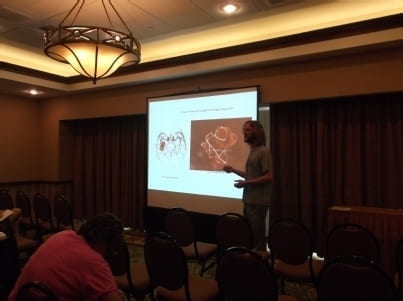
Is Mathematics Science?
The GK-12 MAVS Project is a program funded by the National Science Foundation (NSF) at The University of Texas at Arlington designed to expose junior high and high school students to graduate level mathematics in their classroom in a way that is appropriate and connected to the K-12 school curriculum. We will present activities from several different lessons designed to draw a link between the subject commonly known as science and the scientific subject commonly known as mathematics. The link is made through applied mathematics research involving numerical simulations of medical imaging of blood clots. These lessons were developed for the NSF GK-12 MAVS Project and implemented in a seventh-grade mathematics classroom.